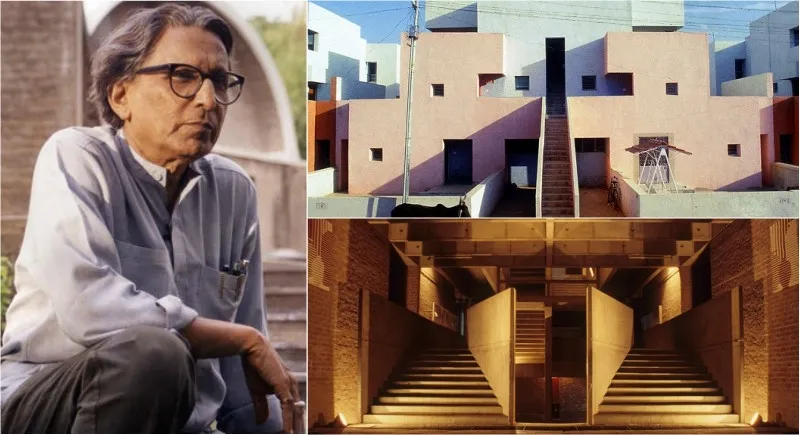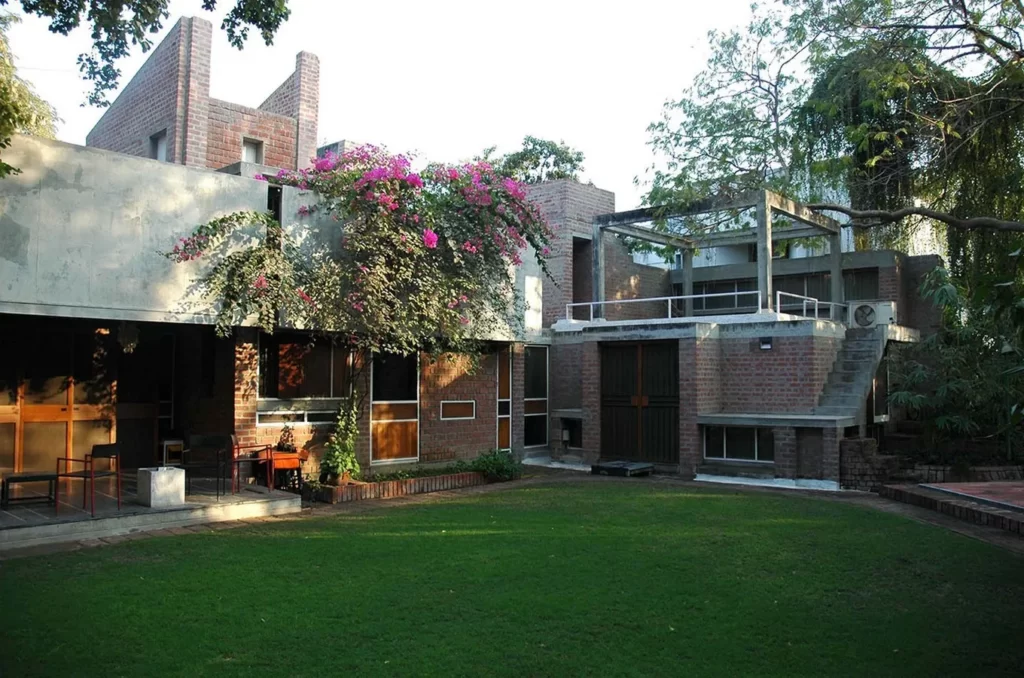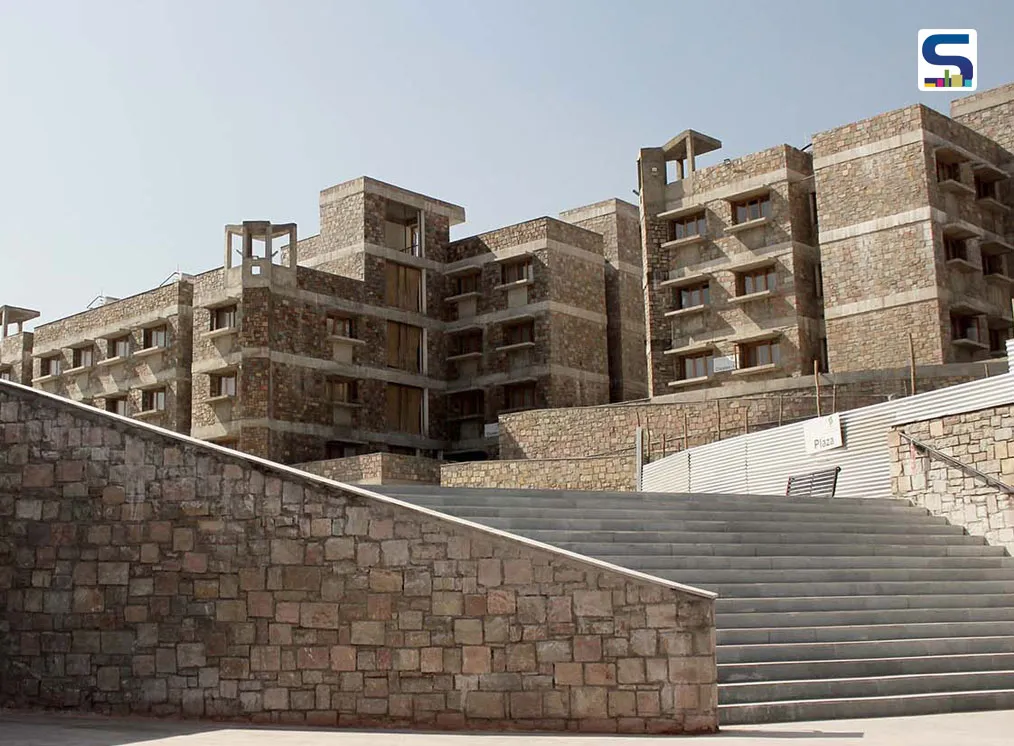If you want to know about the staircase design or landscape garden or requirements for disabled persons in a building, please click the link.
Introduction
Balkrishna Vithaldas Doshi, also known as B.V. Doshi, is an Indian architect who is considered to be one of the most influential figures in modern Indian architecture. He was born on August 26, 1927, in Pune and he died on 24 January 2023, India. Doshi studied architecture at the Sir J.J. School of Architecture in Mumbai and later went on to work with the famous French architect, Le Corbusier, in Paris.

Doshi’s architecture is characterized by his use of traditional Indian architectural principles combined with modernist design elements. He has designed a wide range of projects including public buildings, private residences, educational institutions, and urban planning projects.
Doshi’s notable achievements and awards include the Padma Shri in 1976, the Padma Bhushan in 1991, and the Padma Vibhushan in 2020, which are among the highest civilian honors given by the Government of India. He was also awarded the prestigious Pritzker Architecture Prize in 2018, which is considered to be the highest honor in the field of architecture. Doshi is the first Indian architect to receive this award, which recognizes his significant contribution to architecture and his impact on Indian architecture.
1) Early Life and Education
B.V. Doshi was born on August 26, 1927, in Pune, India. He grew up in a large, middle-class Gujarati family, where he was exposed to art, literature, and music at a young age. His father was a civil servant, and his mother was a homemaker, and he died on 24 January 2023.
Doshi was interested in art and design from a young age, and he initially considered pursuing a career in painting. However, he eventually decided to study architecture and enrolled at the Sir J.J. School of Architecture in Mumbai, where he received his degree in 1950.
After completing his education, Doshi worked for several years in London and Paris, where he gained valuable experience working with prominent architects like Le Corbusier and Louis Kahn. In 1956, he returned to India and established his own architectural practice in Ahmedabad.
Throughout his career, Doshi has been committed to education and has served as a visiting professor and lecturer at several institutions, including the School of Architecture at Ahmedabad and the University of Pennsylvania. He has also been involved in a number of urban planning initiatives and has been a strong advocate for sustainable design and green building practices.
2) Career of B.V. Doshi
B.V. Doshi’s professional career spans over seven decades and has been marked by a wide range of projects that include public buildings, private residences, educational institutions, and urban planning projects. His architectural style is characterized by his use of traditional Indian architectural principles combined with modernist design elements. He believes in the integration of architecture with nature and has been a pioneer in sustainable design practices.
One of Doshi’s most notable works is the Indian Institute of Management in Bangalore, which he designed in 1977. This project is a prime example of Doshi’s design philosophy, which emphasizes the use of local materials, passive cooling systems, and the integration of open spaces with buildings. The campus is designed to be a pedestrian-friendly environment that encourages interaction and collaboration among students and faculty.

Another significant project by Doshi is the Aranya Low-Cost Housing project in Indore, which was designed in the 1980s. This project aimed to provide affordable housing for low-income families and has been recognized as one of the most successful low-cost housing projects in the world. The project incorporates a range of housing types and sizes, as well as common spaces and community facilities.

Doshi’s notable contributions to the field of architecture include his emphasis on sustainability and his focus on social responsibility. He has also been a strong advocate for education and has been involved in the development of several architecture schools in India. In addition, he has been an influential figure in the development of urban planning policies in India and has played an important role in shaping the built environment of several Indian cities.
Doshi’s architectural style and design philosophy have had a significant impact on the field of architecture, both in India and globally. His emphasis on sustainability and social responsibility has inspired many architects and has contributed to the growing movement towards sustainable design and green building practices.
3) Awards and Recognition
B.V. Doshi has received numerous awards and recognition for his significant contribution to the field of architecture. He has been honored both nationally and internationally for his work, which has been recognized for its innovative design, sustainability, and social impact.
Some of Doshi’s most prestigious awards include:
- The Pritzker Architecture Prize: In 2018, Doshi became the first Indian architect to receive the Pritzker Architecture Prize, which is considered the highest honor in the field of architecture. The award recognizes his significant contribution to architecture and his impact on Indian architecture.
- Padma Vibhushan: In 2020, Doshi was awarded the Padma Vibhushan, which is the second-highest civilian award in India. The award recognized his contribution to the field of architecture and his service to society.
- Padma Bhushan: Doshi was also awarded the Padma Bhushan in 1991, which is the third-highest civilian award in India. The award recognized his contribution to the field of architecture.
- Aga Khan Award for Architecture: Doshi has been the recipient of several Aga Khan Awards for Architecture. He was recognized for his work on the Indian Institute of Management in Bangalore in 1992 and the Aranya Low-Cost Housing project in Indore in 1993.
- Global Award for Sustainable Architecture: In 2007, Doshi was awarded the Global Award for Sustainable Architecture, which recognizes architects who have made significant contributions to sustainable design practices.
- Lifetime Achievement Award from the Indian Institute of Architects: In 1995, Doshi received a Lifetime Achievement Award from the Indian Institute of Architects, which recognized his significant contribution to the field of architecture in India.
These awards and recognition are a testament to Doshi’s significant contribution to the field of architecture, both in India and globally. His work has inspired generations of architects and has helped shape the built environment in India and beyond.
4) Philosophy and design principles of B.V. Doshi
B.V. Doshi’s design philosophy is rooted in his belief that architecture should be responsive to the needs of people and the environment. He emphasizes the importance of sustainability, social responsibility, and the integration of traditional Indian architectural principles with modern design.
Here are some of his key design principles:
- Human-centered design: B.V. Doshi believes that architecture should be designed with the needs of people in mind. He emphasizes the importance of creating spaces that are comfortable, functional, and aesthetically pleasing.
- Sustainability: B.V. Doshi is committed to designing buildings that are environmentally sustainable. He emphasizes the use of locally sourced materials, natural ventilation, and other sustainable design features.
- Contextual design: B.V. Doshi believes that architecture should be designed in response to its surrounding environment. He emphasizes the importance of creating buildings that are sensitive to their context and that fit harmoniously into their surroundings.
- Integration of traditional Indian architectural principles: B.V. Doshi believes that traditional Indian architectural principles, such as the use of courtyards and verandas, can be incorporated into modern design to create more human-centered and sustainable buildings.
- Collaborative design process: B.V. Doshi emphasizes the importance of collaboration between architects, engineers, and other stakeholders in the design process. He believes that this collaborative approach leads to better design outcomes that are more responsive to the needs of people and the environment.
These design principles are evident in B.V. Doshi’s work, which is characterized by its use of natural materials, human-centered spaces, and sustainable design features. His work has had a significant impact on the field of architecture and has inspired a new generation of architects to adopt more sustainable and human-centered design practices.
5) Impact on Indian Architecture
B.V. Doshi’s work has had a profound impact on the Indian architectural landscape. He is considered one of the most influential architects of the modern era in India and has helped shape the development of modern Indian architecture. His emphasis on sustainability, social responsibility, and the integration of traditional Indian architectural principles with modern design has influenced many architects and has contributed to the development of a unique Indian architectural style.
One of the key ways in which Doshi’s work has influenced Indian architecture is through his emphasis on sustainable design practices. His focus on using locally sourced materials, passive cooling systems, and the integration of green spaces with buildings has inspired many architects in India to adopt similar practices. This has contributed to the growing movement towards sustainable design and green building practices in India.
Doshi’s work has also had an impact on the development of urban planning policies in India. His involvement in several urban planning initiatives has helped shape the built environment of several Indian cities, and his emphasis on pedestrian-friendly environments and the integration of public spaces has influenced the development of urban spaces in India.
Doshi’s emphasis on the integration of traditional Indian architectural principles with modern design has also had an impact on Indian architecture. His work has helped revive interest in traditional Indian architecture, and many architects in India are now incorporating traditional Indian design elements into their work. This has contributed to the development of a unique Indian architectural style that is recognized globally.
Overall, Doshi’s work has had a significant impact on Indian architecture and has contributed to the development of a unique Indian architectural style that emphasizes sustainability, social responsibility, and the integration of traditional Indian architectural principles with modern design. His work has inspired many architects and has helped shape the built environment of India.
6) Sustainability in Architecture
B.V. Doshi’s philosophy on sustainability in architecture is grounded in his belief that architecture should be environmentally responsible and socially conscious. He believes that architects have a responsibility to design buildings that are sustainable, efficient, and cost-effective while also responding to the needs of the people who use them.
Doshi’s sustainable design practices are based on the principle of reducing the environmental impact of buildings. He emphasizes the use of locally sourced materials and the integration of natural systems to reduce energy consumption and create a healthier indoor environment.
Some of his sustainable design practices include:
- Passive cooling systems: Doshi’s designs often incorporate passive cooling systems that use natural ventilation and shading to reduce the need for artificial cooling.
- Water conservation: Doshi emphasizes the importance of water conservation in his designs. He incorporates rainwater harvesting systems and water-efficient fixtures in his buildings to reduce water consumption.
- Use of natural materials: Doshi’s designs often incorporate locally sourced materials, such as stone and brick, which are renewable and have a lower carbon footprint than many conventional building materials.
- Integration of green spaces: Doshi believes that integrating green spaces with buildings can help reduce the urban heat island effect and provide a healthier environment for building occupants. He often incorporates green roofs, courtyards, and gardens into his designs.
- Adaptive reuse: Doshi is a strong advocate of adaptive reuse, which involves repurposing existing buildings rather than demolishing and rebuilding them. This approach reduces waste and conserves resources.
Overall, Doshi’s philosophy on sustainability emphasizes the importance of designing buildings that are not only environmentally responsible but also respond to the needs of the people who use them. His sustainable design practices have had a significant impact on the field of architecture and have inspired many architects to adopt similar practices in their designs.
7) Major Works of B.V. Doshi
Balkrishna Vithaldas Doshi, commonly known as B.V. Doshi, is a celebrated Indian architect known for his sustainable design practices, social responsibility, and the integration of traditional Indian architectural principles with modern design. Here are some of his major works:
i) Indian Institute of Management Bangalore (1977-1992):

This iconic building is known for its unique design, which incorporates landscaped courtyards, curved roofs, and a series of interconnected spaces.
Aranya Low-Cost Housing, Indore (1989):

This project aimed to provide affordable housing for low-income families in India. The design incorporates a variety of housing types, ranging from small apartments to individual homes, and includes a range of amenities and public spaces.
Amdavad ni Gufa, Ahmedabad (1994):

This underground art gallery is located in a park in Ahmedabad and features a unique cave-like design. The structure is made from a series of curved concrete shells, and the interior is decorated with intricate murals and sculptures.
Sangath, Ahmedabad (1980):

This architectural studio was designed by Doshi for his own use. The design incorporates a series of vaulted roofs, which help to create a natural cooling system, as well as a series of courtyards and gardens.
Tagore Memorial Hall, Ahmedabad (1967):

This cultural center is located in the heart of Ahmedabad and features a unique design inspired by the traditional Indian stepwell. The structure is made from concrete and incorporates a series of stepped terraces and landscaped gardens.
Life Insurance Corporation Housing, Ahmedabad (1973):

This project is a housing complex designed for the employees of the Life Insurance Corporation of India. The design incorporates a variety of housing types, ranging from small apartments to larger homes, and includes a range of amenities such as community spaces, parks, and playgrounds.
Premabhai Hall, Ahmedabad (1976):

This community center was designed to host cultural and social events in Ahmedabad. The design incorporates a series of courtyards and gardens, as well as a unique curved roof that helps to create a natural ventilation system.
Kamala House, Ahmedabad (1963):

This private residence was designed for a prominent Indian businessman and features a unique design that incorporates a series of interconnected courtyards and gardens. The structure is made from concrete and features a range of intricate details, such as sculpted windows and ornamental screens.
Indian Institute of Management Udaipur (2013):

This campus is located in Rajasthan and was designed to be a sustainable and energy-efficient building. The design incorporates a series of courtyards, gardens, and terraces, as well as a range of sustainable features such as solar panels, rainwater harvesting systems, and natural ventilation systems.
These are just a few examples of B.V. Doshi’s notable works. His designs are characterized by their use of natural systems, locally sourced materials, and the creation of human-centered spaces. His work has had a significant impact on the Indian architectural landscape and has inspired a new generation of architects to adopt sustainable design practices and integrate traditional Indian architectural principles into their work.
8) Legacy of B.V. Doshi
B.V. Doshi’s legacy in the field of architecture is significant. He has made a lasting impact on the profession through his contributions to sustainable design, social responsibility, and the integration of traditional Indian architectural principles with modern design. His work has influenced architects not only in India but also around the world.
One of the key ways in which Doshi’s work has influenced the field of architecture is through his emphasis on sustainability. His focus on using locally sourced materials, passive cooling systems, and the integration of green spaces with buildings has inspired many architects to adopt similar practices. This has contributed to the growing movement towards sustainable design and green building practices globally.
Doshi’s work has also had an impact on the development of urban planning policies. His involvement in several urban planning initiatives has helped shape the built environment of several Indian cities, and his emphasis on pedestrian-friendly environments and the integration of public spaces has influenced the development of urban spaces in India and beyond.
Doshi’s influence on the future of architecture is significant. His emphasis on sustainability, social responsibility, and the integration of traditional Indian architectural principles with modern design has inspired a new generation of architects to embrace these principles in their work. His legacy has contributed to the growing awareness of the need for environmentally responsible and socially conscious architecture.
In addition to his architectural work, Doshi has also been an influential teacher and mentor to many architects. He has taught at several prestigious institutions, including the School of Architecture at Ahmedabad, and has influenced the education of countless architects who have gone on to make their own contributions to the profession.
Overall, B.V. Doshi’s legacy in the field of architecture is significant. His work has had a profound impact on the profession, and his emphasis on sustainability, social responsibility, and the integration of traditional Indian architectural principles with modern design has inspired a new generation of architects to embrace these principles in their work.
9) Conclusion
In summary, B.V. Doshi’s contribution to the field of architecture is significant and far-reaching. His sustainable design practices, social responsibility, and integration of traditional Indian architectural principles with modern design have inspired countless architects and will continue to influence the field for years to come.